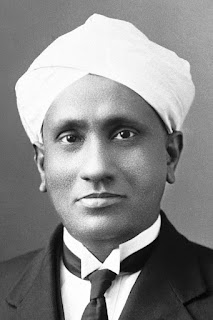National Science Day and The First Indian Nobel Laureate for Science
हा लेख मराठीतून वाचण्यासाठी येथे क्लिक करा.
Sir Chandrasekhara Venkata Raman was born on 07 November 1888. His groundbreaking research on the scattering of light earned him the 1930 Nobel Prize in Physics. Sir C. V. Raman became the first Indian Nobel Laureate for Science.
(By Nobel Foundation - From Nobel Lectures, Physics 1922-1941, Elsevier Publishing Company, Amsterdam, 1965, Public Domain
In the 19th century, Lord Rayleigh discovered an elastic scattering of light (photons). This phenomenon is now known as Rayleigh Scattering (the phenomenon that explains why the sky is blue). In this scattering, the wavelength of the incident light is conserved after scattering from particles smaller than the wavelength. On 28 February 1928, the results of Raman led experiments on the scattering of light, at the Indian Association for the Cultivation of Science (IACS), Kolkata with collaborators, including K. S. Krishnan were published. In these experiments, he discovered an inelastic scattering of light. He discovered that in the scattering of light, a fraction of photons (1 in 10 million) has wavelengths different from that of the incident light, unlike the conservation of wavelength in Rayleigh scattering. This phenomenon is now known as the Raman Effect.
Based on the Raman effect, a spectroscopic technique known as Raman spectroscopy was developed. Raman spectroscopy is frequently used in chemistry to provide a fingerprint by which molecules can be identified. Raman detectors, used for detecting the safety of materials, use Raman spectroscopy.
Sir C. V. Raman was honoured with India's highest civilian award, the Bharat Ratna in 1954. To commemorate the discovery of the Raman effect, India celebrates National Science Day on 28 February every year.
✍ Sonal Thorve



Very well written.
ReplyDeleteThank you Nisha!
Delete